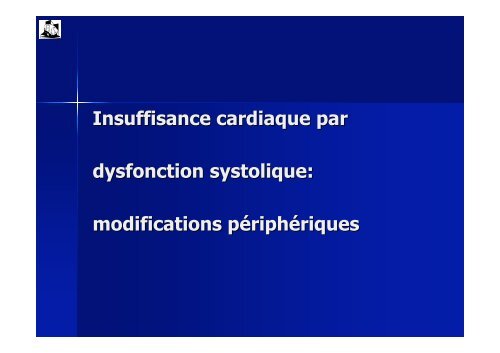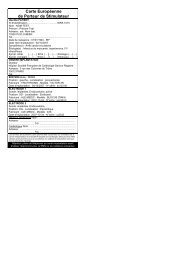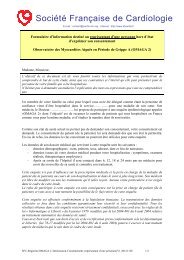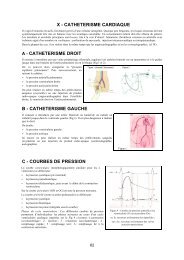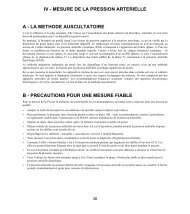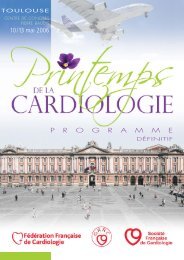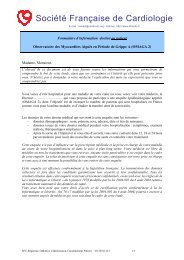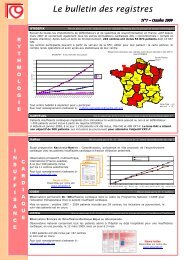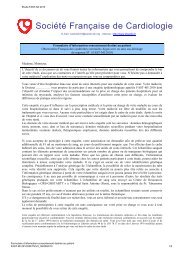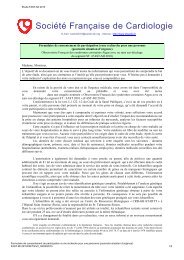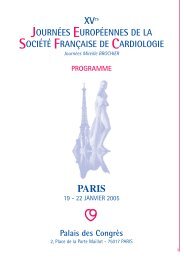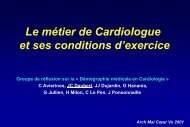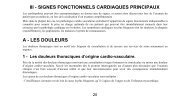Physiopathologie de l'insuffisance cardiaque
Physiopathologie de l'insuffisance cardiaque
Physiopathologie de l'insuffisance cardiaque
You also want an ePaper? Increase the reach of your titles
YUMPU automatically turns print PDFs into web optimized ePapers that Google loves.
Insuffisance <strong>cardiaque</strong> par<br />
dysfonction systolique:<br />
modifications périphériques
Dissociation FEVG VO 2<br />
VeHF 1 VeHF 2<br />
Circulation, 1993;87:VI-5
Maillons <strong>de</strong> la chaîne<br />
VO2 = Qc (CaO2 - CvO2)<br />
– Qc: facteur <strong>cardiaque</strong><br />
– CaO2: facteur respiratoire<br />
– CvO2: facteur périphérique
Maillons <strong>de</strong> la chaîne<br />
O2<br />
O2<br />
ENERGIE<br />
O2
Coeur ?<br />
dobutamine au<br />
pic <strong>de</strong> l'effort<br />
et VO2<br />
Maskin et coll Am J Cardiol 1983;51:177-82
Respiratoire ?<br />
<br />
<br />
<br />
Modifications <strong>de</strong>s paramètres <strong>de</strong> diffusion <strong>de</strong><br />
l'O2<br />
– syndrome obstructif<br />
– Pas <strong>de</strong> désaturation du sang artériel à l'effort:<br />
Modification <strong>de</strong>s paramètres <strong>de</strong> ventilation<br />
diminution <strong>de</strong> la capacité vitale<br />
augmentation <strong>de</strong> l'espace mort<br />
augmentation <strong>de</strong> la ventilation pour une même VO2<br />
– Réserve ventilatoire préservée ou augmentée<br />
Si un facteur respiratoire est limitant, c'est<br />
indirectement<br />
inconfort créé par le problème pulmonaire qui limite<br />
l'exercice<br />
bénéfice <strong>de</strong> l'entraînement respiratoire ?
Sujets normaux<br />
normaux Bergh U. et<br />
coll J Appl Physiol 1976;41:191<br />
10<br />
% augmentation VO2 max<br />
avec les bras vs jambes seules<br />
0<br />
-10<br />
-20<br />
-30<br />
10% 20% 30% 40% 100% optimal<br />
% travail total avec les bras
Population<br />
19 insuffisants <strong>cardiaque</strong>s<br />
– 16 hommes, , 3 femmes<br />
– âge moyen 58 ans (47 à 67 ans)<br />
– fraction d'éjectionopathies primitives<br />
– Sans artérite <strong>de</strong>s membres inférieurs<br />
7 sujets normaux<br />
– sé<strong>de</strong>ntaires
Métho<strong>de</strong>s<br />
charge (kpm)<br />
ajout <strong>de</strong>s bras (Qr=1)<br />
temps (mn)
Résultats
Modifications en<br />
microscopie <strong>de</strong>s cellules<br />
musculaires<br />
squelettiques<br />
Drexler et al<br />
Circulation<br />
1992;85:1751
Modifications du<br />
métabolisme <strong>de</strong>s cellules<br />
musculaires squelettiques<br />
au cours <strong>de</strong> l'effort<br />
Massie et coll. Circulation 1987
Decreased skeletal<br />
muscle mass<br />
mid calf magnetic resonance imaging<br />
Congestive heart failure<br />
Normal<br />
Mancini et al. Circulation 1992;1364-1373
Circulation 2006;114:126<br />
<br />
<br />
<br />
<br />
Cachexia >7.5% body weight loss compared to<br />
prior to first event (AMI…)<br />
body composition dual-energy x -ray absoptiometry<br />
modified bruce<br />
ergoreflex test:<br />
– 50% mas load finger flexion repeated until exhaustion or<br />
cycling at 60% load for 5 min<br />
– i<strong>de</strong>m + venous and arterial occlusion before end of<br />
exercise for 3 minutes<br />
– 107 patients, 24 controls
Circulation 2006;114:126<br />
contribution refex sur<br />
ventil > chez cachectic
Circulation 2006;114:126<br />
contribution refex sur<br />
ventil > chez cachectic
6<br />
Femoral Vein O2<br />
content (ml/100ml)<br />
4<br />
2<br />
n=58<br />
r=0.72<br />
p
Maillons <strong>de</strong> la chaîne<br />
O2<br />
O2<br />
ENERGIE<br />
O2
Débit maximal<br />
sujets normaux<br />
insuffisants <strong>cardiaque</strong>s<br />
AVANT-BRAS<br />
JAMBE
Débit max et VO 2<br />
25<br />
25<br />
y = 0.3x + 7<br />
r = 0.58<br />
n = 46<br />
p < 0.0001<br />
15<br />
15<br />
5<br />
0<br />
20<br />
40 60<br />
Débit maximal<br />
80<br />
5<br />
5<br />
15<br />
25<br />
Débit maximal<br />
35<br />
(ml/min.100ml)<br />
(ml/min.100ml)<br />
AVANT-BRAS<br />
JAMBE
Réponse à la NTG<br />
Nx (n=6)<br />
IC (n=19)<br />
NTG 10-7M NTG 10-7 NTG 10-5<br />
n=6 n=19 n=10<br />
Contrôle 10,7 ± 2,4 7,4 ± 4,7 5,7 ± 4,1<br />
NTG 21,7 ± 3,6 10,8 ± 4,6 28,7 ± 12
L'entraînement physique ↑<br />
la réponse endothéliale humaine<br />
Hornig Circulation 1996;93:210-4<br />
12 insuffisants<br />
<strong>cardiaque</strong>s et 7 normaux<br />
↑ Ø artère radiale après<br />
occlusion avant-bras 8<br />
min<br />
avec et sans L-NMMA<br />
(bloque<br />
formation NO,<br />
65% <strong>de</strong> la réponse à<br />
l'acetylcholine)<br />
Entraînement: : 4<br />
semaines <strong>de</strong> "handgrip"
Diminution du débit <strong>de</strong><br />
l'artère caroti<strong>de</strong> commune<br />
par occlusion <strong>de</strong>l'artère<br />
caroti<strong>de</strong> externe<br />
Avec et sans endothelium<br />
<br />
Pas <strong>de</strong> diminution du<br />
diamètre <strong>de</strong>s artères dans<br />
<strong>l'insuffisance</strong> <strong>cardiaque</strong>
Limitation centrale ou<br />
périphérique ?<br />
Entrainement physique, IEC aux longs cours…<br />
l/min<br />
Dobutamine, IEC aigu…<br />
débit <strong>cardiaque</strong> maximal (Qc)<br />
débit maximal admis en périphérie (Ql)<br />
VO2 maximale<br />
Limitation périphérique<br />
Qc > Ql<br />
Limitation centrale<br />
Qc < Ql<br />
aggravation<br />
amélioration
Chronic ACEI and peak VO2<br />
Mancini et al. J Am Coll Cardiol 1987;10:845-50<br />
Drexler et al Circulation 1989;79:491
Progressivement…<br />
J Am Coll Cardiol 1983;2:755
Effets aigus ne permettent pas <strong>de</strong><br />
prévoir les bénéfices à long terme
Chronic ACEI: role of the<br />
periphery<br />
Increase in VO2<br />
(%)<br />
L after ACEI<br />
DVO 2 10%<br />
Effect of arm cranking on peak<br />
VO 2
emo<strong>de</strong>lling
Effet <strong>cardiaque</strong> <strong>de</strong>s<br />
IEC:<br />
limite dilatation VG
NZ (taille VG)
MIRACLE Circ 2003;107:1985<br />
QRS>130 ms, LVEDD>55 mm, LVEF
FACTEUR INITIAL<br />
Surcharge volume<br />
IM, IAo<br />
Surcharge pression<br />
RA,HTA<br />
Perte myocytes<br />
IDM, Myocardite, Age<br />
EFFETS VENTRICULAIRES<br />
"REMODELING"<br />
Hypertrophie<br />
Dilatation<br />
IM fonctionnelle<br />
s diastole<br />
† myocytes<br />
Elongation<br />
"Slippage"<br />
Déficit énergétique<br />
EFFETS PERIPHERIQUES<br />
"INSUFFISANCE CARDIAQUE"<br />
¯ fonction systolique<br />
postcharge<br />
Fraction d'éjection VG<br />
(%)<br />
70<br />
60<br />
50<br />
40<br />
30<br />
20<br />
10<br />
0<br />
>50<br />
30<br />
FE VG<br />
ASYMPTOMATIQUE I II III IV<br />
28<br />
VO2<br />
20<br />
¯ chronique du flux<br />
Dysfonction endothéliale<br />
24<br />
15<br />
10<br />
30<br />
20<br />
10<br />
0<br />
VO 2<br />
(ml/kg/min)
Remo<strong>de</strong>lage: Pc<br />
Circulation. 2003;108:833
Remo<strong>de</strong>lage après IDM
99 first infarction<br />
Gaudron P, Circulation 1993;87:755<br />
Dilation: more anterior, larger, TIMI lower at 3-5 weeks<br />
thrombolysis 60% dans les 3 groupes
Conclusion<br />
Insuffisance <strong>cardiaque</strong><br />
– maladie générale<br />
cœur: remo<strong>de</strong>lage<br />
périphérie: limitation fonctionnelle<br />
– valeurs pronostiques indépendantes<br />
– cibles pour le traitement


